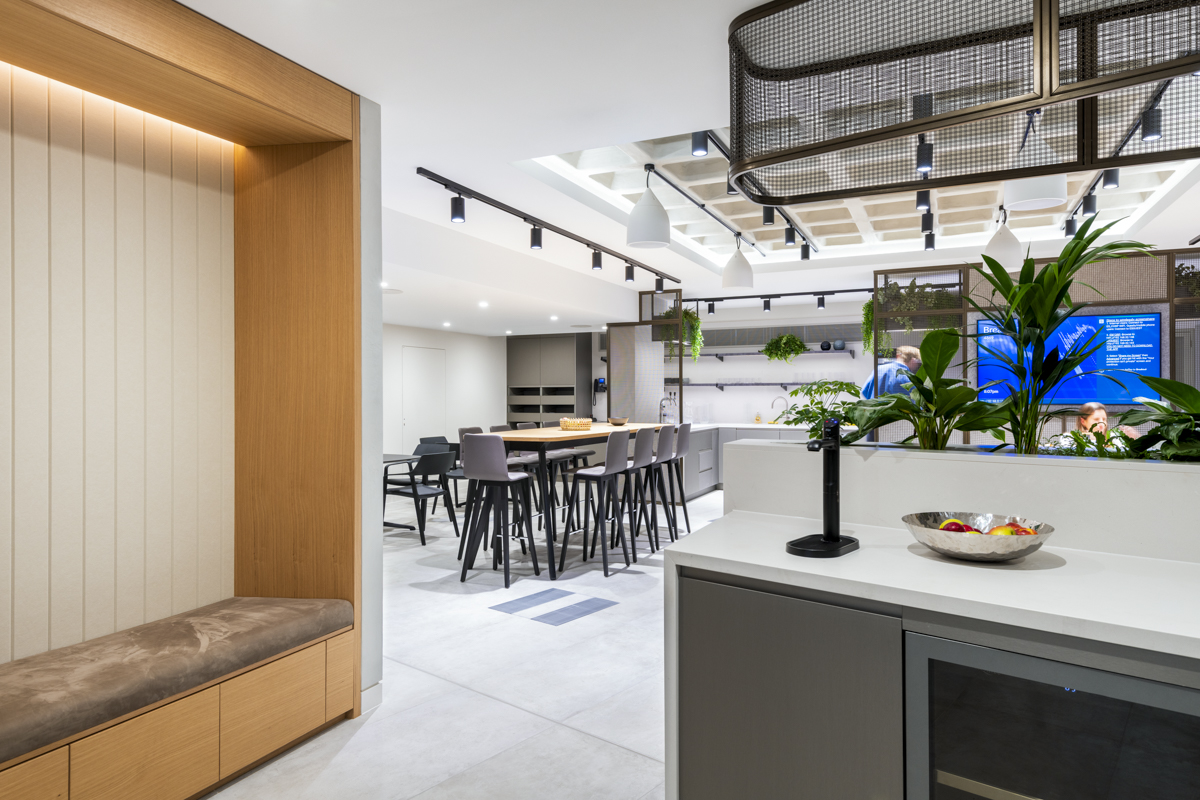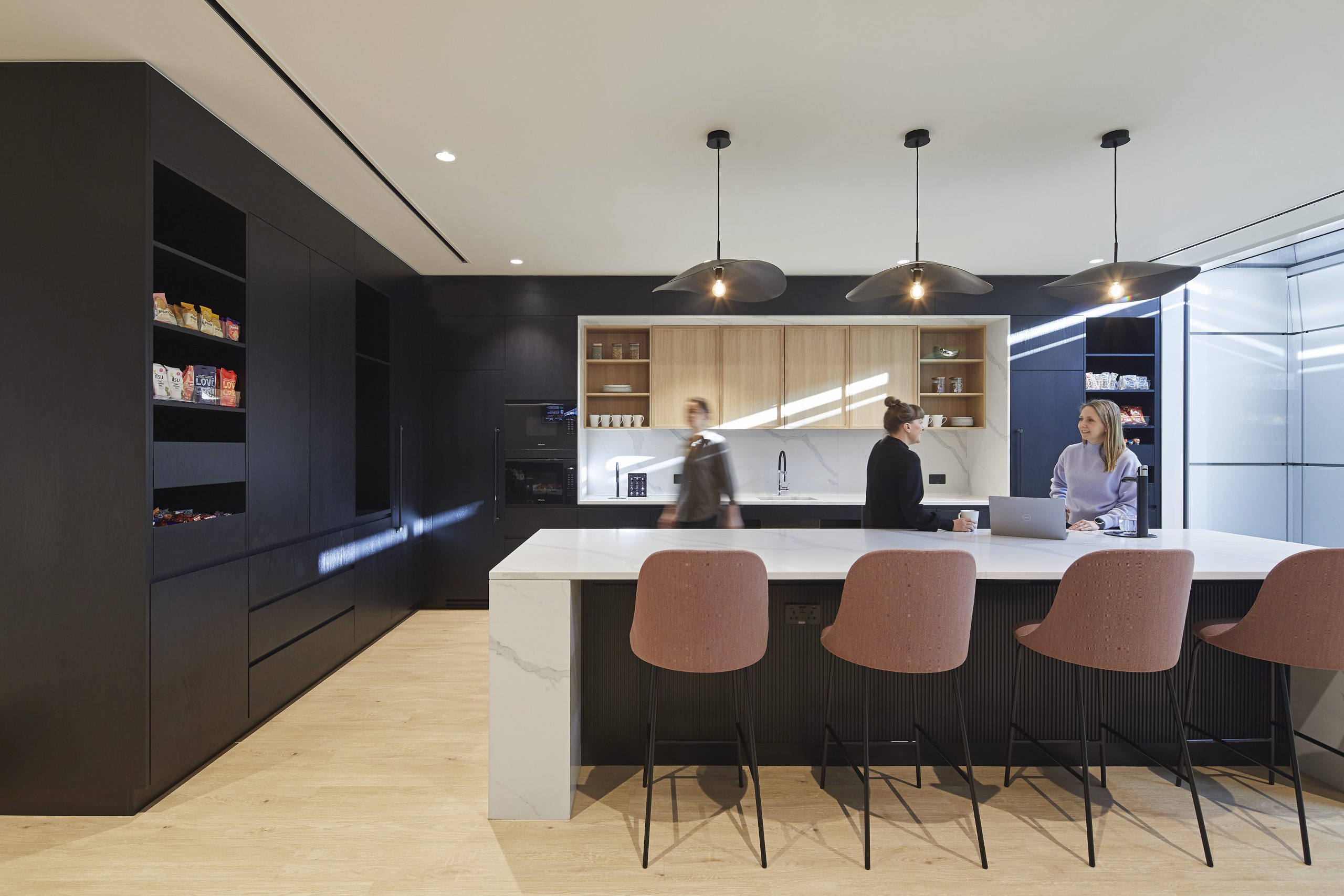
The Importance of Office Kitchen Design
More than ever, offices are paying attention to tea points and kitchen areas, in recognition that these spaces are not just functional spaces for lunch and tea breaks, but important social areas in the workplace.
A well-designed office kitchen isn’t just about where to locate the coffee machine and microwave – it’s careful consideration about creating a hub for collaboration and socialising, client and supplier meetings and an important part of company culture.
This article explores aspects of office kitchen design, from the latest trends and ergonomics to sustainability, budgeting, and the impact on employee well-being. Each section is backed by insights and real-world examples, along with some exemplary tea points and kitchen areas for our work on London office fit-outs.
Contents
- 1. Are Tea points the New Watercooler Moments?
- 2. Trends in Office Tea points & Kitchen Design
- 3. Ergonomics & Functionality
- 4. Sustainability & Eco-Friendly Materials
- 5. Cost Considerations & Budgeting
- 6. Impact on Employee Well-Being & Productivity
- 7. How K2 Space Can Help You Build the Perfect Kitchen and Tea Point?
1. Are Tea points the New Watercooler Moments?
A thoughtfully designed kitchen provides a neutral meeting ground for colleagues who might rarely see each other, helping to build social bonds in a blended work environment. This supports interdepartmental mingling and spontaneous “watercooler” moments.
In fact, casual collisions over coffee can spark innovative ideas that might not surface in formal meetings. Many companies also use food and coffee as a draw. One survey found 86% of employees said free snacks or meals would encourage them to return to the office. By creating a kitchen that doubles as a welcoming lounge, employers make the workplace more attractive for hybrid staff.
2. Trends in Office Tea points & Kitchen Design
More than ever, offices are paying attention to tea points and kitchen areas, in recognition that these spaces are not just functional spaces for lunch and tea breaks, but important social areas in the workplace.
A well-designed office kitchen isn’t just about where to locate the coffee machine and microwave – it’s careful consideration about creating a hub for collaboration and socialising, client and supplier meetings and an important part of company culture.
This article explores aspects of office kitchen design, from the latest trends and ergonomics to sustainability, budgeting, and the impact on employee well-being. Each section is backed by insights and real-world examples, along with some exemplary tea points and kitchen areas for our work on London office fit-outs.
Modern Aesthetics & Materials
Office kitchens have become integral to workplace design. It’s no longer acceptable to provide only the bare essentials. Companies are incorporating the comfort and ease of home into the office kitchen. This includes using high-quality finishes, contemporary lighting, and furniture that wouldn’t be out of place in a café or living room.
Natural materials and biophilic elements are popular. Adding plants or natural wood accents creates a calming, refreshing ambiance and encourages people to linger, chat and socialise. In fact, incorporating biophilic design (greenery, natural light, organic textures) can in fact boost creativity and reduce stress among employees.
Colour palettes are also evolving; many offices opt for clean, neutral bases with pops of bold colour to energise the space. Some companies are also including brand colours (more on that further on).
The Influence of Hybrid Working on Tea Point Design
The rise of hybrid work has influenced office kitchen design in several ways. With employees not always in the office, the kitchen has become a central social hub on the days they are on-site.
Designers are creating inviting communal areas to entice staff back and facilitate the face-to-face interactions that remote work lacks. The office kitchen is often where the workday begins – grabbing a coffee or breakfast – and it sets a welcoming tone. It’s also the way staff break up the day, grab impromptu meetings, and take a break from their desks. Because people move more fluidly around hybrid offices, having a communal space to connect is crucial.
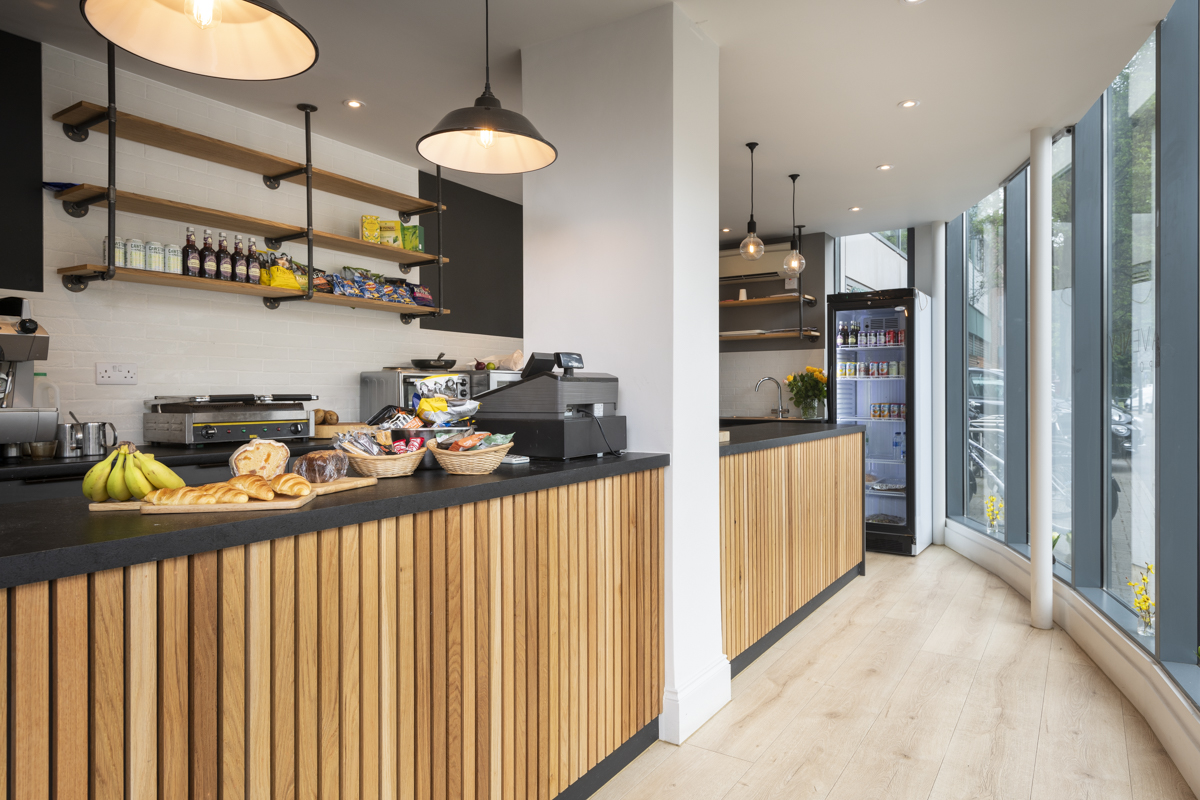
Project: Glenstone
3. Ergonomics & Functionality
Designing an office kitchen isn’t just about looks – ergonomics and functionality are paramount so that the space works smoothly for all users. A well-planned kitchen minimises congestion, is easy to use for everyone (regardless of height or ability), and can adapt to multiple purposes.
The Kitchen Work Triangle
One classic design principle that still applies to office kitchens is the “kitchen work triangle” – positioning the sink, fridge, and primary appliance (in offices, often a microwave or coffee machine) in a triangle formation to minimise walking distance.
Keeping these three points 4 to 9 feet apart (with no obstacles between) creates a seamless flow and avoids bottlenecks, even when several people use the space at once. In an office context, this might mean situating the refrigerator, sink, and coffee station within that comfortable triangle allowing easy access for your employees.
Work Zones
Speaking loosely, designers typically talk about work zones rather than a strict triangle. For example, one corner of the kitchen might form a self-contained coffee bar, while another area is a snack prep zone. Having distinct “micro-zones” within a kitchen helps distribute traffic.
The goal is to enable multiple people to grab whatever they need without jostling each other. Practical details make a big difference: placing cups, mugs, and coffee supplies right next to the coffee machine and storing plates and utensils near the fridge or sink are simple steps to streamline routines. An efficient layout means employees can quickly fix a drink or lunch and get back to work (or back to socialising) with minimal hassle.
Employee Flow & Accessibility
Good office kitchen design accounts for the ebb and flow of users throughout the day. Peak times like the lunch rush or 3pm coffee break can lead to crowding if the space isn’t planned for circulation. To avoid this, plan for crowd flow: ensure there are wide pathways (design guidelines often suggest at least 24 inches, ~60 cm, of clearance between appliances or counter edges) so people can move past each other comfortably.
For instance, if someone is adding milk at the coffee counter, there should still be room for another person to walk behind them to the sink. Teapoints (sometimes more commonly known as kitchen islands) can help separate prep areas from walking routes. It’s also wise to separate functional zones – e.g. keep the main food prep or sink area apart from where people might just be pouring coffee – to prevent traffic jams.
Additional Accessibility Considerations
Ergonomics also means considering users of all abilities. An office kitchen should be accessible to employees who use wheelchairs or have other disabilities. This can involve features like a section of counter at a lower height for wheelchair access, lever-handle faucets that are easy to operate, and clear space under sinks or counters for leg room.
Appliances should be mounted at reachable heights (for example, a microwave in a base cabinet pull-out drawer or not too high above a counter). Flooring should be slip-resistant and thresholds flush to prevent trips. These design considerations ensure the kitchen is efficient and safe for every employee, complying with inclusive design best practices.
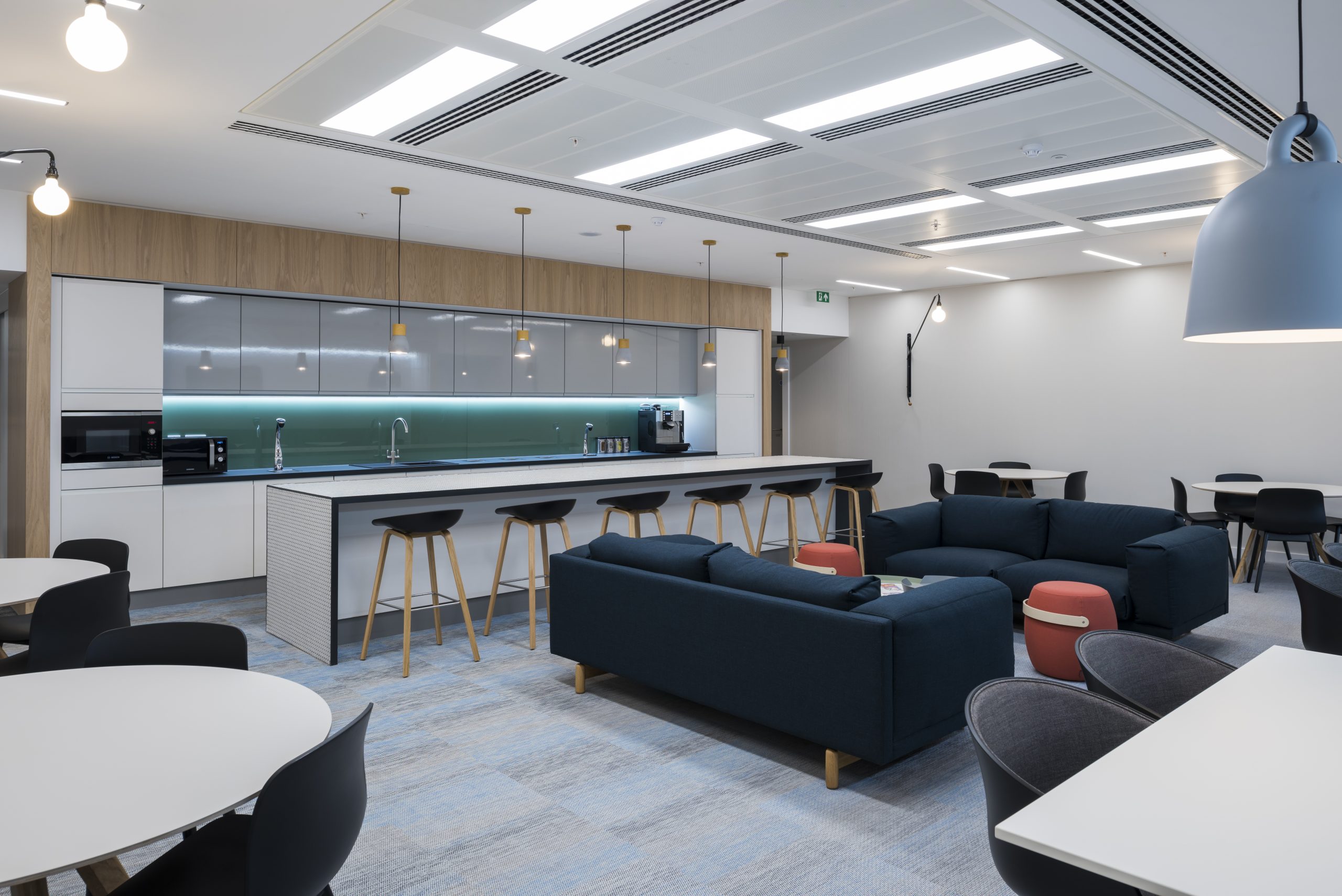
Kitchens as Breakout Spaces
Office kitchens often double as impromptu meeting areas, breakout spaces, or even alternative work zones, so they must be versatile. Designers are embracing multi-functional furniture – for example, a kitchen tea point that also serves as a standing meeting table, or a counter that extends into a high-top table for lunch, or a quick sharing of information on a laptop.
Importantly, an office kitchen shouldn’t be overlooked as an additional work setting. They can successfully host spontaneous brainstorming sessions or “touchdown” work if equipped right. For instance, simply having a few outlets or USB charging points near seating areas can encourage people to bring their devices and work in the kitchen for a change of scenery.
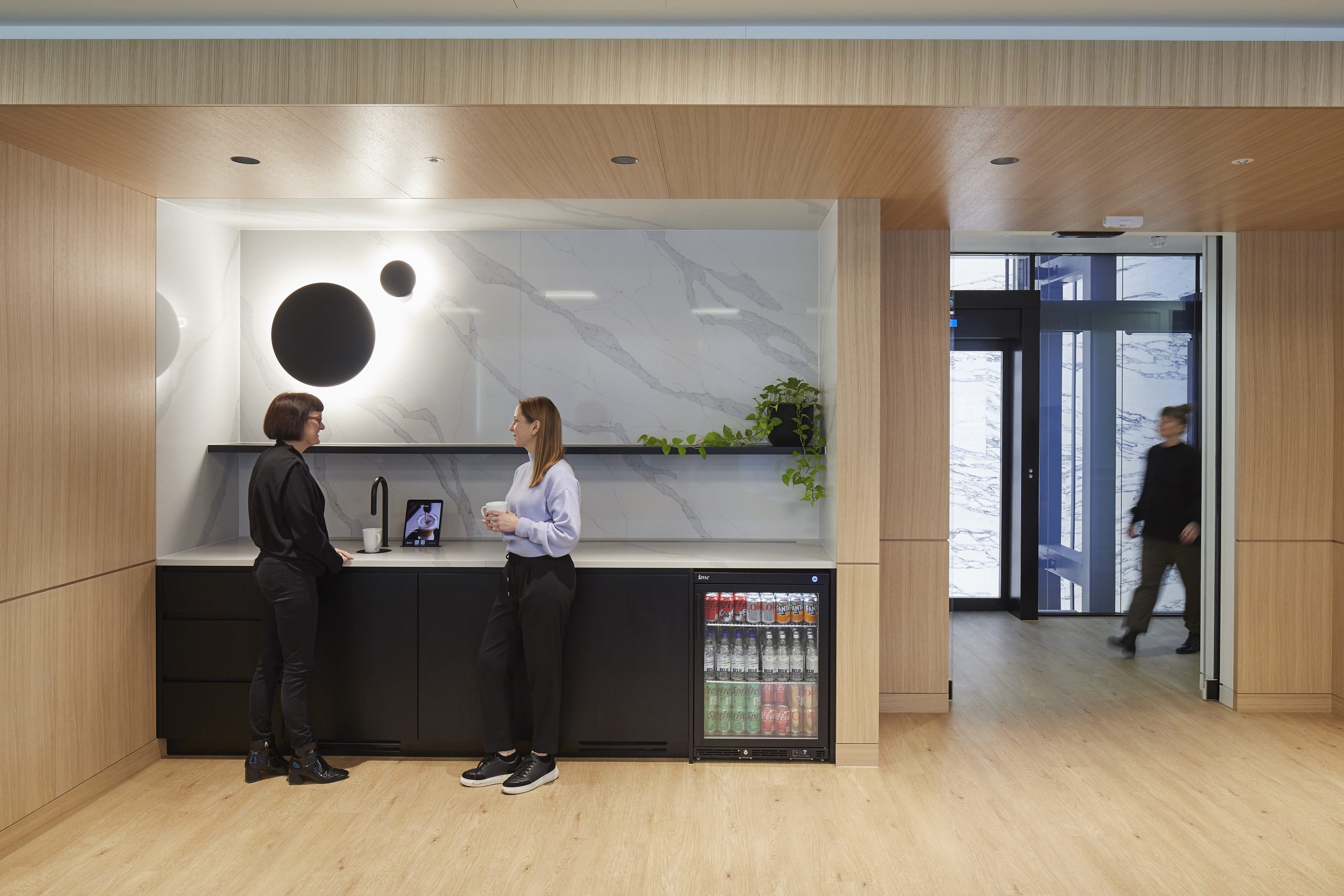
4. Sustainability & Eco-Friendly Materials
Sustainability is a major focus in modern office fit-outs, and the kitchen/tea point is a prime candidate for green initiatives. An eco-friendly office kitchen can reduce energy consumption, minimise waste, and serve as a daily reminder of a company’s commitment to the environment. Here’s how sustainability factors into office kitchen design:
Energy-Efficient Kitchen Appliances
Kitchens typically run appliances throughout the day – including fridges, dishwashers, coffee machines, etc. Choosing energy-efficient models can yield significant savings in the long run and reduce the office’s carbon footprint. Look for appliances with high energy-efficiency ratings – ones designed to use less electricity and water without sacrificing performance. Modern refrigerators can use up to 40% less energy than older models – a huge improvement in a device that runs 24/7.
Energy-efficient, high EPC rated dishwashers save water by using smart sensors to adjust cycle length based on the load’s dirtiness, and they often have internal heaters that use less power. Even choosing an induction cooktop or microwave over a traditional electric hotplate can save energy, as induction units heat more directly and quickly.
Many offices also install motion sensors or timers for kitchen lighting, so lights aren’t left on in an empty break room. Smart appliance choices can optimise efficiency.
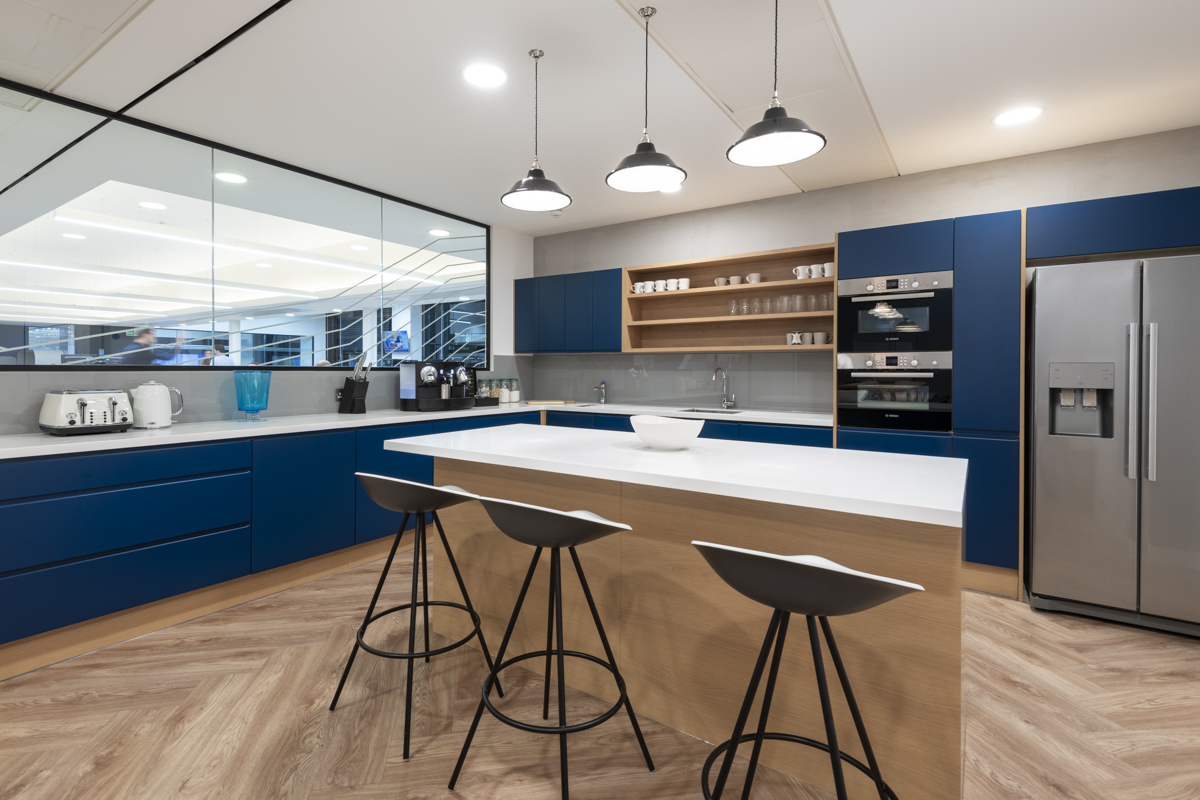
Sustainable Materials & Waste Reduction:
The choice of materials in an office kitchen can also support sustainability goals. Instead of carbon-intensive or non-renewable materials, many designers opt for eco-friendly finishes. For example, countertops made of recycled glass or composite surfaces with recycled content are gaining popularity – they offer unique style while repurposing post-consumer materials.
Bamboo is another green choice, used for anything from cabinetry to countertop butcher blocks; bamboo regenerates extremely fast and is considered a highly renewable resource. Using reclaimed wood for cabinets or shelving not only gives a warm, characterful look but also prevents that wood from going to waste (and avoids new deforestation). Importantly, any wood used can be specified as FSC-certified, meaning it comes from responsibly managed forests.
Low-VOC (volatile organic compound) paints and sealants are also preferred to maintain healthy indoor air quality. Sustainability extends to what happens in the kitchen daily: providing convenient recycling and compost bins encourages employees to sort their waste and reduce what goes to landfill.
Companies can cut down single-use plastics by, for instance, supplying mugs and glasses instead of disposable cups, and stocking bulk condiments or milk rather than individual packets. Offices may also implement food waste reduction programs.
Some companies are using AI-powered systems with cameras that monitor exactly what food gets thrown away, helping canteens cut down on waste. The system can identify types of waste (like how much salad or sandwich crusts are discarded) and then advise on purchasing and preparation to avoid over-ordering. While typically used in larger cafeterias or hotels, this technology can be scaled to any workplace with significant food service.
However, even without AI, a sustainable office kitchen might include things like a countertop food digester or compost unit to handle organic waste, or simply a schedule for donating excess catered food. The aim is to send as little as possible to the waste bin. Companies are increasingly aware that these daily practices in the kitchen reflect their broader sustainability values and ESG goals.
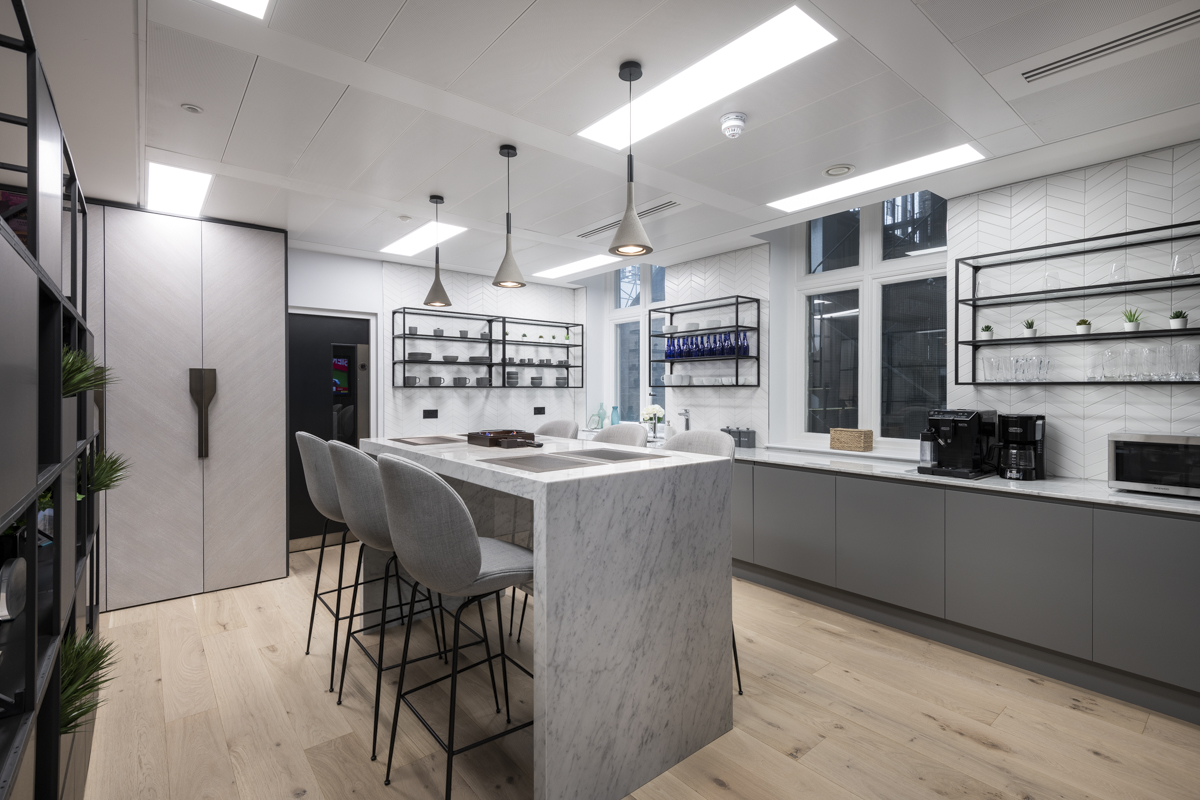
5. Cost Considerations & Budgeting
Designing or refurbishing an office kitchen requires balancing aspirations with budget realities. Cost considerations range from upfront fit-out expenses to the long-term value that a quality kitchen provides. In this section, we look at budgeting strategies, how to weigh cost vs. benefit, and the ROI (return on investment) of investing in high-quality office kitchens. Cost considerations are key.
Office kitchens can deliver significant long-term value, both tangible and intangible. Investing in durable materials and appliances may raise the initial price tag, but it pays off by extending the kitchen’s lifespan. High-footfall in kitchens can quickly wear out cheaper cabinetry, which might chip or delaminate within a few years, whereas sturdy, commercial-grade materials will still look throughout your lease. As such, using high-quality materials is an excellent investment; not only do they last longer, they signal to employees that the company cares about providing a quality environment.
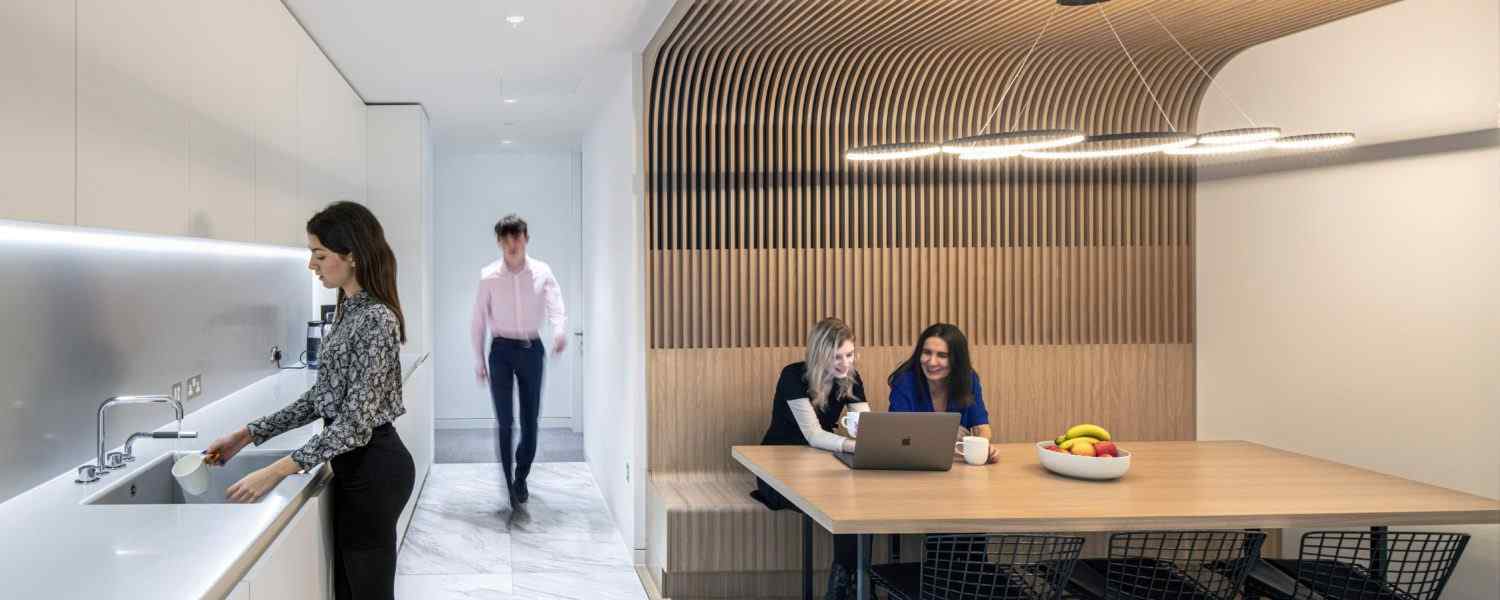
Long-term value can be quantified in some cases. For example, equipping the kitchen with energy-efficient appliances can lower utility bills for years to come, directly saving money. A well-planned kitchen might also reduce spend on things like catering or off-site meetings – if you have a great space to brew coffee and host clients, you might spend less at the café next door.
Furthermore, an appealing kitchen can protect the value of an office space: if subleasing or valuation is a concern, having a modern, attractive breakout area is seen as a plus by tenants and buyers. In short, while cutting corners on a kitchen fit-out might save costs initially, those savings could be eclipsed by higher maintenance, more frequent refurbishments, or missed benefits down the road. It’s about finding the sweet spot where initial cost and long-term value meet.
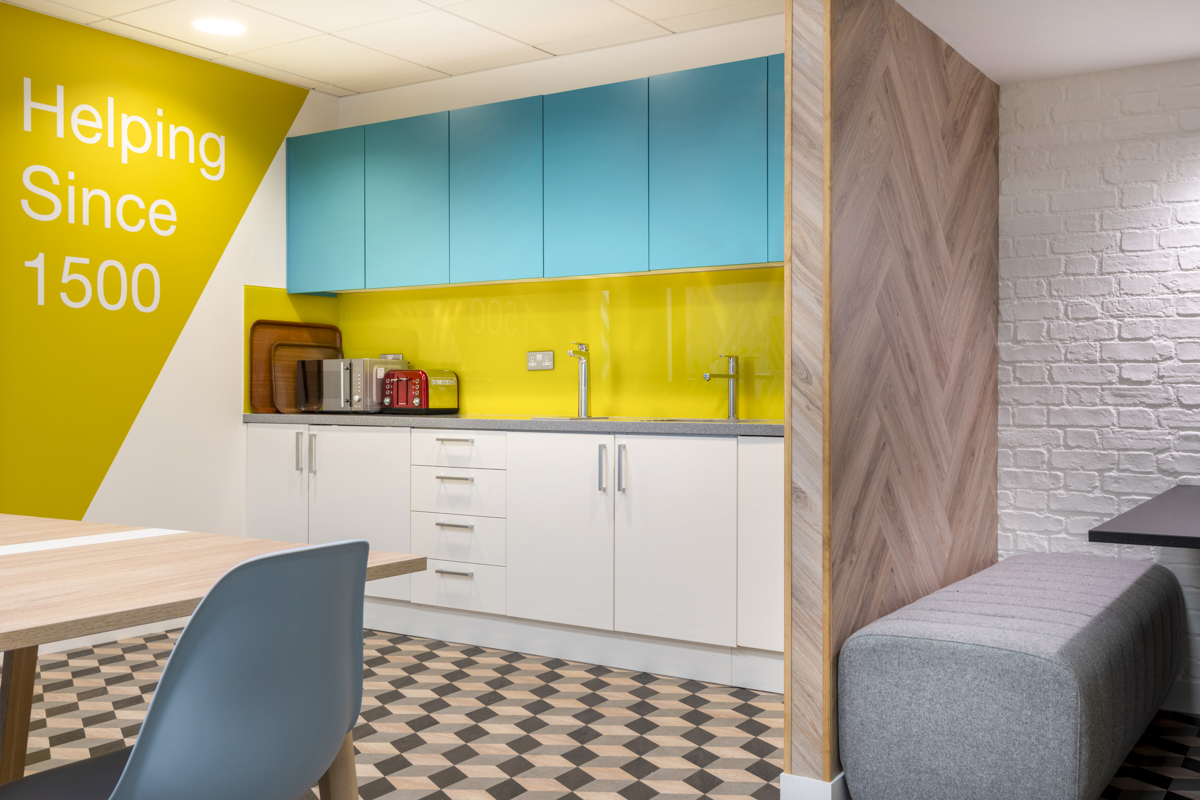
6. Impact on Employee Well-Being & Productivity
A well-designed office tea point or kitchen can have a surprisingly large impact on employee well-being, satisfaction, and productivity. These spaces contribute to workplace culture and give employees a place to recharge both physically (with food and drink) and mentally (through relaxation and socialising).
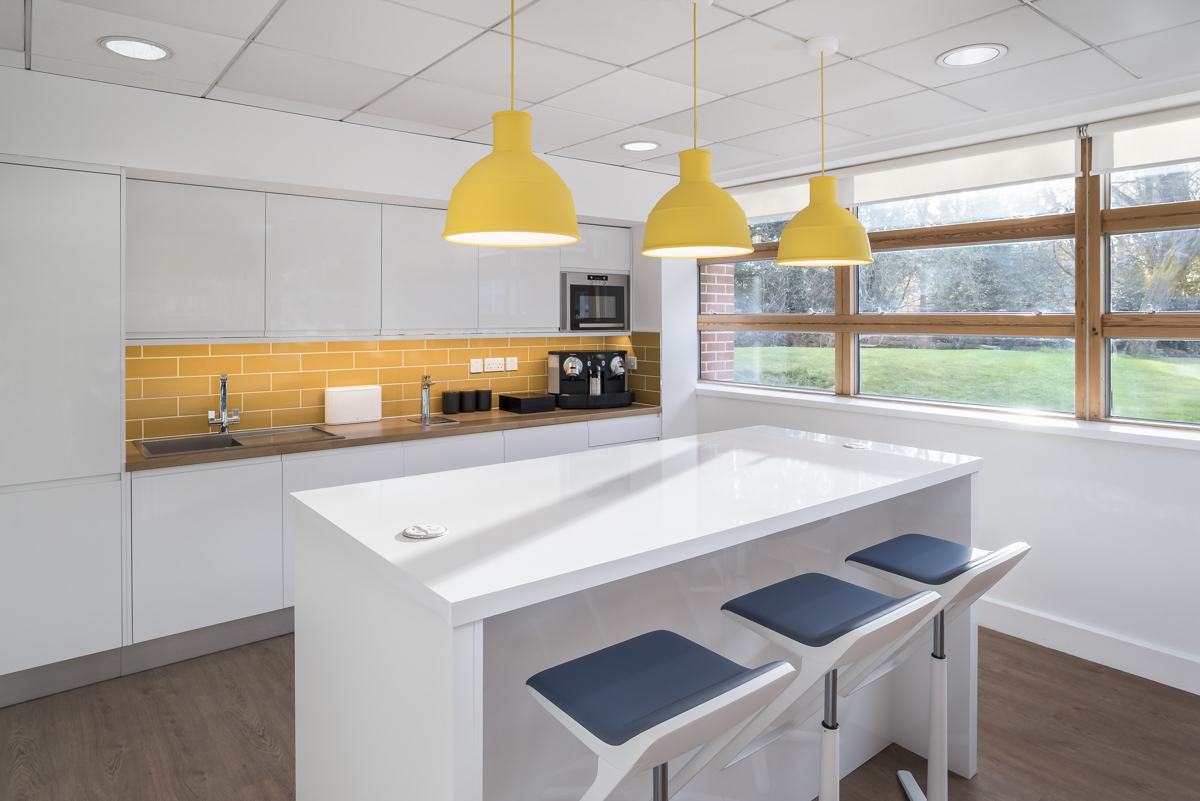 Project: Santen
Project: SantenProductivity and Performance Impacts:
A quality office kitchen can indirectly (and sometimes directly) improve productivity. One way is through the time savings and convenience it offers. If your office provides free coffee or snacks, employees don’t need to leave the building and queue at a café, meaning shorter breaks and more time on the job (not to mention the goodwill from such perks).
Additionally, being able to quickly fix a cup of tea in 3 minutes versus 10 minutes of fiddling with a old kettle adds up over hundreds of instances. But beyond recouping minutes, the kitchen’s biggest impact on productivity is by creating happier, healthier employees who can perform at their best. Studies have linked employee engagement and satisfaction with higher productivity levels. Access to food and a space to socialise ranks high in what employees value – in one survey, 67% of employees with access to free food at work reported being “extremely” or “very” happy with their job.
Another poll found that 92% of workers consider a well-stocked coffee and lunch space important for socialising and would like such spaces in the office. Happiness matters: engaged employees are more creative and go the extra mile. Moreover, those casual chats in the kitchen can lead to knowledge sharing or problem-solving that directly benefits work.
There’s evidence that in-person social interactions improve mood more than virtual ones, and good moods correlate with better cognitive performance. Also, by fostering interdepartmental connections, the kitchen can help improve collaboration on work projects, as colleagues are more comfortable communicating.
As mentioned earlier, spontaneous brainstorming in a relaxed environment can yield innovative ideas – some of the greatest ideas are born in these informal settings. Finally, consider the flip side: a lack of proper break space can harm productivity. If employees are eating at their desk due to no break room, they might not disconnect even briefly, leading to afternoon slumps. Or if they must go outside for every coffee, valuable work time and focus can be lost.
7. How K2 Space Can Help You Build the Perfect Kitchen and Tea Point?
At K2 Space, we know that a kitchen or tea point is much more than a spot for coffee—it’s the central hub where culture, collaboration, and creativity converge. Our approach transforms traditional break areas into dynamic spaces that not only meet functional needs but also embody your brand’s personality.
Our work at DTRE’s Mayfair headquarters, for example, involved creating a kitchen and tea point that would also be a vibrant gathering space. High-quality finishes, energy‐efficient appliances, and flexible seating were used to create an inviting environment that encourages employees to linger, chat, and recharge. This design blends modern aesthetics with ergonomic functionality to support both spontaneous interactions and structured meetings.
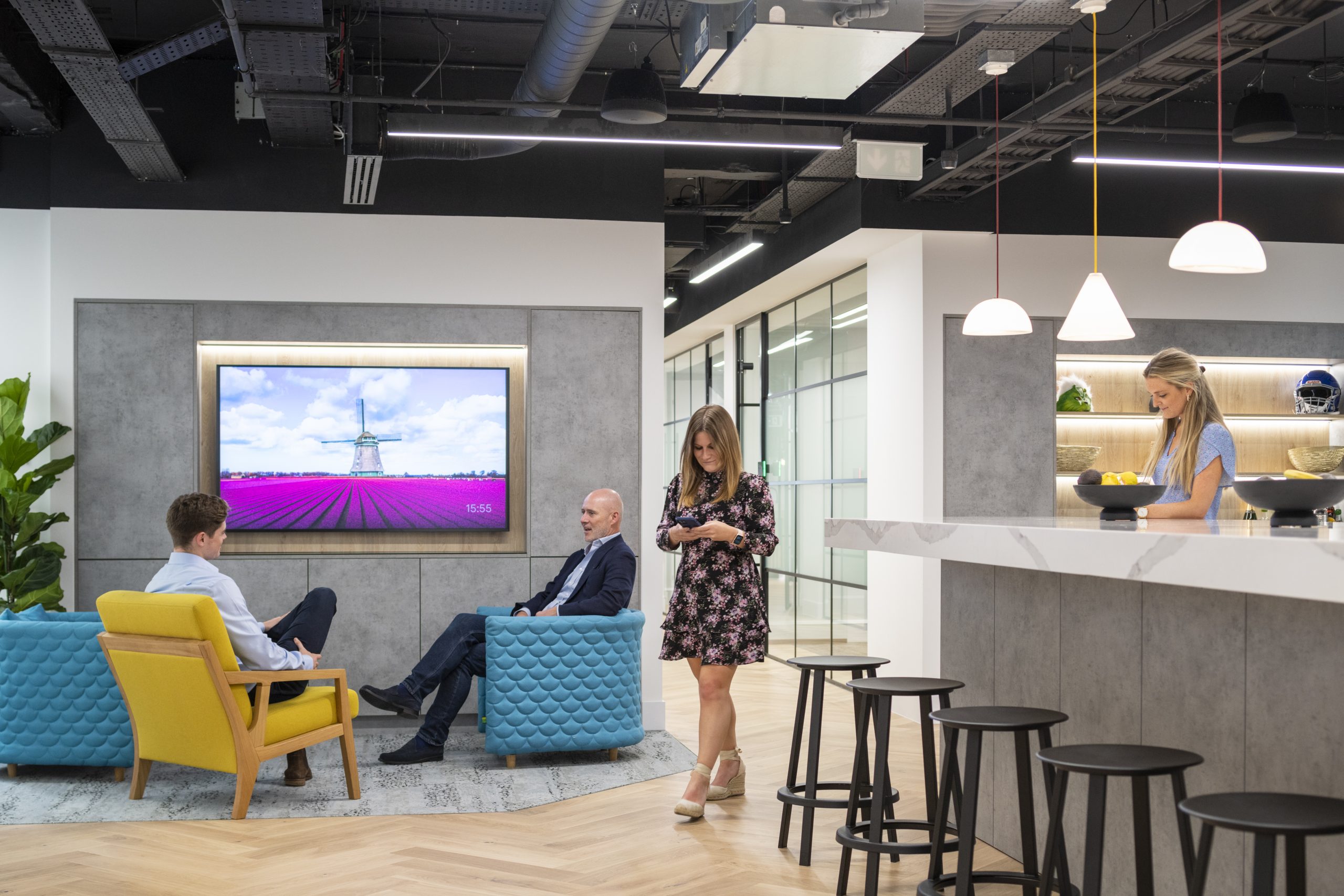
But DTRE is no exception to our work on other projects. In fact, we tailor each project to reflect your unique identity. At K2 Space, we integrate signature brand elements such as custom neon art, bespoke colour palettes, and branded accessories to ensure that your space isn’t just functional, but a true extension of your corporate culture.
Our portfolio speaks for itself. From the refined, elegant teapoint at Glenstone Property to the innovative, eye-catching designs at Netflix Madrid and the iconic circular tea point seen below at Criteo’s London office, our work is a testament to the transformative power of thoughtful design. These case studies illustrate how an inspiring kitchen can become a strategic asset—enhancing employee well-being, fostering community, and even boosting productivity.
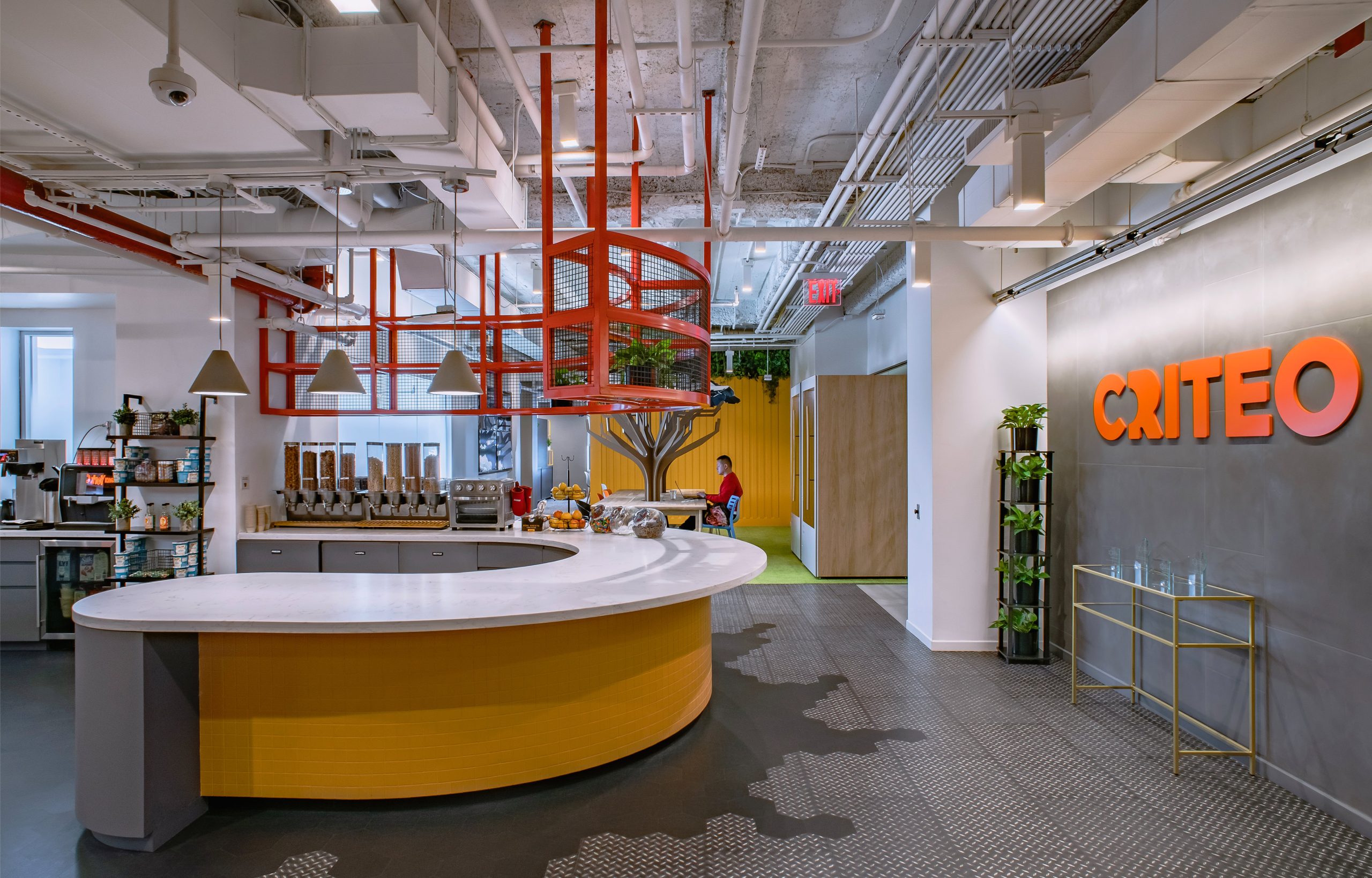
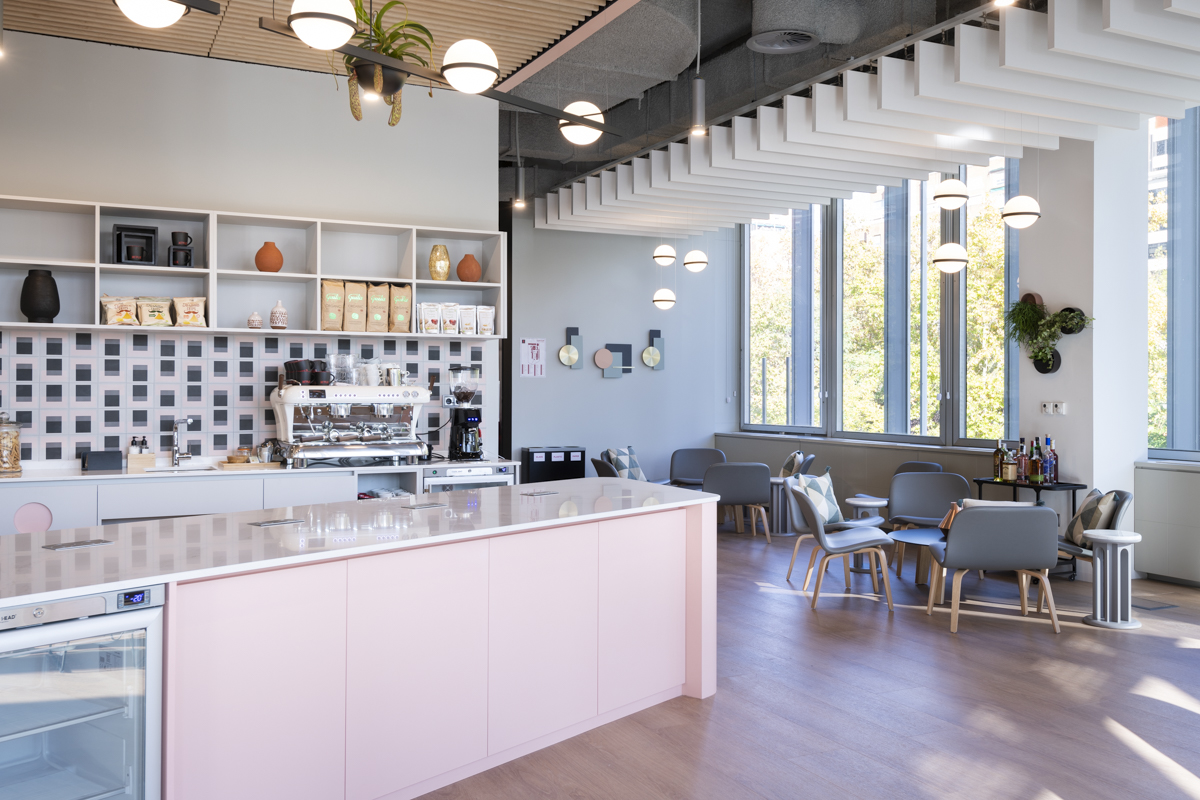
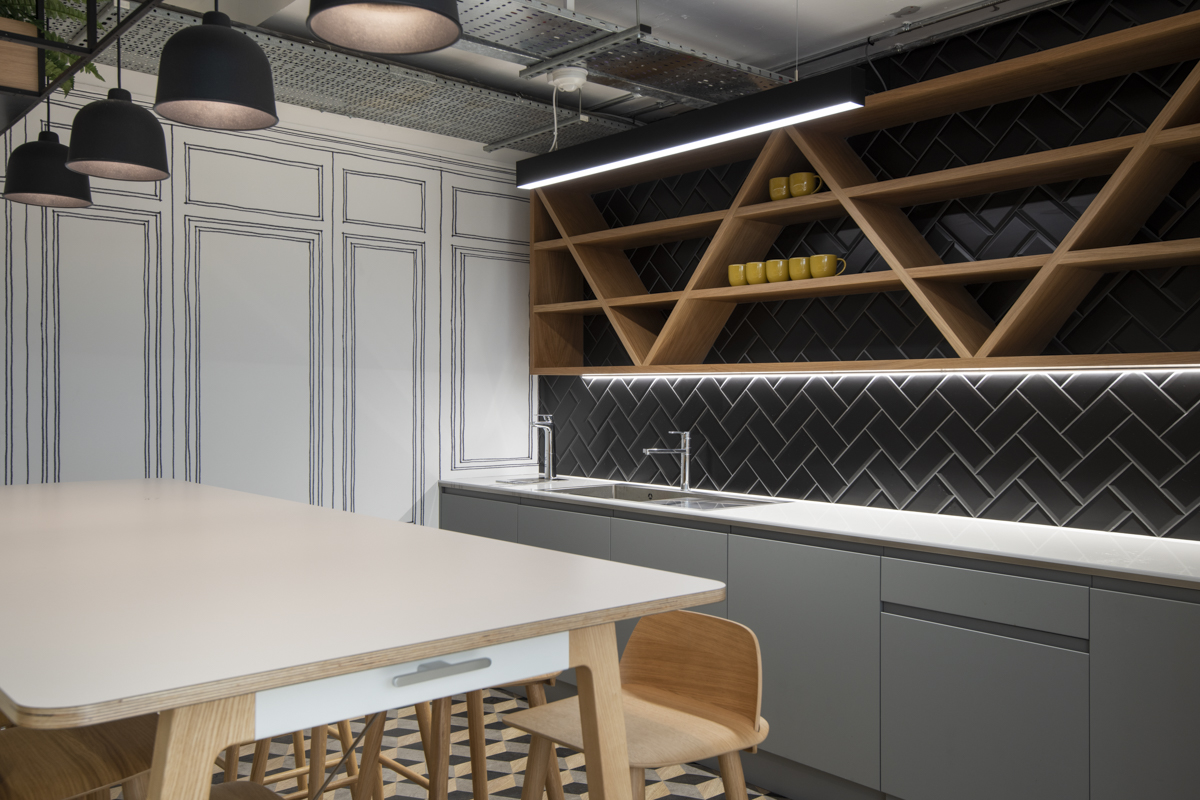
At K2 Space, our mission is to create kitchens and tea points that redefine the workplace. Whether you want a space that ignites conversation, reinforces your brand, or simply offers a much-needed break from the daily grind, we can help you achieve a design that elevates your entire office environment. Let’s work together to build a kitchen that not only meets your practical needs but also inspires and connects your people.
